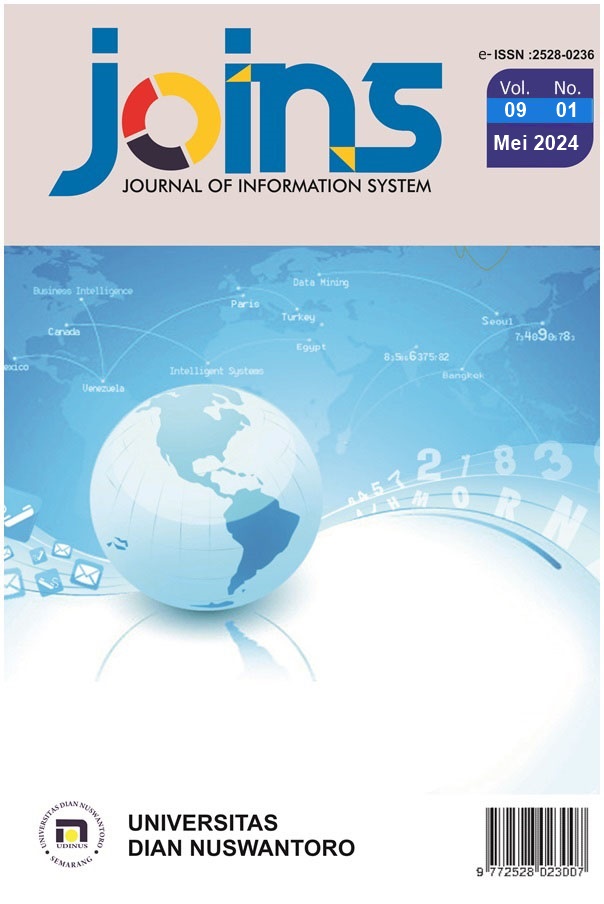Analisa Deteksi Citra Kerusakan pada Body Mobil dengan Menggunakan Metode Deteksi Tepi Canny
DOI:
https://doi.org/10.33633/joins.v9i1.10550Keywords:
segmentasi citra, deteksi tepi canny, noise filtering, kerusakan bodi mobilAbstract
Kendala dalam penggunaan bahan perbaikan body mobil sering kali muncul akibat analisis kerusakan yang tidak tepat yang hanya berdasarkan pengamatan mata. Kendala ini juga menjadi hambatan bagi perusahaan asuransi kendaraan dalam menentukan klaim yang sepadan dengan tingkat kerusakan. Untuk itu, peneliti mengajukan metode baru dalam menganalisis kerusakan body mobil dengan menggunakan segmentasi citra deteksi tepi canny berbasis algoritma Canny. Metode ini mampu mengidentifikasi garis tepi pada gambar kerusakan body mobil dan mengkalkulasi persentase piksel tepi yang menunjukkan tingkat kerusakan. Selain itu, penelitian ini juga mengaplikasikan noise filtering dengan algoritma Machine Learning untuk meningkatkan kualitas gambar sebelum proses segmentasi. Implementasi metode ini dilakukan dengan menggunakan software MatLab versi 2015a.References
X. Yan, et al., “A Method of Lane Edge Detection Based on Canny Algorithm,” in Proceedings of IEEE, Jinan, China, 2017.
M. F. Rozi, et al., “Klasifikasi Kecacatan Keramik Dengan Menggunakan Deteksi Tepi Canny Dan Metode Hough Line Transform,” J-Eltrik, vol. 1, no. 2, Teknik Elektro Universitas Trunojoyo, Bangkalan, 2019.
J. Qaddour, et al., “Automatic damaged vehicle estimator using enhanced deep learning algorithm,” Intelligent Systems with Applications, vol. 18, no. 200192, School of Information Technology, Illinois State University, Illinois, USA, 2023.
N. Dhieb, et al., “A Very Deep Transfer Learning Model for Vehicle Damage Detection and Localization,” in Proceedings of IEEE, New Jersey, USA, 2019.
U. Waqas, et al., “Vehicle Damage Classification and Fraudulent Image Detection Including Moiré Effect Using Deep Learning,” in Proceedings of IEEE, Seoul, South Korea, 2020.
Q. Zhang, et al., “Vehicle-Damage-Detection Segmentation Algorithm Based on Improved Mask RCNN,” ACCESS, vol. 8, Digital Object Identifier 10.1109/ACCESS.2020.2964055, Zhengzhou, China, 2020.
B. Sugandi, et al., “Deteksi Tepi Canny dan RMSE untuk Identifikasi Kerusakan pada Kemasan Minuman,” Jurnal Integrasi, vol. 14, no. 2, pp. 110-113, Batam, 2022.
Y. Fendriani, “Analisis Perbandingan Variasi Filter Pada Deteksi Tepi Menggunakan Metode Canny Terhadap Citra CT-Scan Kanker Paru-Paru,” JoP, vol. 8, no. 2, Jambi, 2023.
M. Harim, et al., “Segmentasi Citra Telapak Tangan menggunakan Deteksi Tepi Prewitt, Sobel, Roberts, dan Canny,” JIMP : Jurnal Informatika Merdeka Pasuruan, vol. 8, no. 1, Kendari, 2023.
I. M. Sitanggang, et al., “Analisis Dan Perbandingan Metode Sobel Dan Canny Pada Deteksi Tepi Citra Daun Sirh Merah,” JIKOMSI [Jurnal Ilmu Komputer dan Sistem Informasi], vol. 3, no. 3, pp. 140-149, Medan, 2021.
L. Maximillian, et al., “Perbandingan Algoritma Sobel dan Canny untuk Deteksi Citra Daun Lidah Buaya,” KOMPUTA : Jurnal Ilmiah Komputer dan Informatika, vol. 12, no. 2, Surabaya, 2023.
L. Zhao, et al., “Research in Improved Algorithm of Infrared Image Edge Detection for Electrical Equipment,” in 2020 Chinese Automation Congress (CAC), Tianjin, China, 2020.
F. A. Rafi, et al., “Sistem Pendeteksi Kerusakan Jalan Aspal Menggunakan Canny Edge Detection,” J-ICON, vol. 11, no. 1, Kupang, 2023.
L. Wang, et al., “Hybrid Image Edge Detection Algorithm Based on Fractional Differential and Canny Operator,” in 2018 11th International Symposium on Computational Intelligence and Design, Hefei, China, 2018.
Z. Zheng, et al., “Adaptive Edge Detection Algorithm Based on Improved Grey Prediction Model,” ACCESS, vol. 8, Digital Object Identifier 10.1109/ACCESS.2020.2999071, Nanjing, China, 2020.
Downloads
Published
How to Cite
Issue
Section
License
Authors who publish with this journal agree to the following terms:
- Authors retain copyright and grant the journal right of first publication with the work simultaneously licensed under a Creative Commons Attribution License that allows others to share the work with an acknowledgement of the work's authorship and initial publication in this journal.
- Authors are able to enter into separate, additional contractual arrangements for the non-exclusive distribution of the journal's published version of the work (e.g., post it to an institutional repository or publish it in a book), with an acknowledgement of its initial publication in this journal.
- Authors are permitted and encouraged to post their work online (e.g., in institutional repositories or on their website) prior to and during the submission process, as it can lead to productive exchanges, as well as earlier and greater citation of published work (See The Effect of Open Access).

This work is licensed under a Creative Commons Attribution 4.0 International License.






















